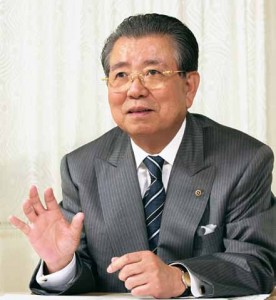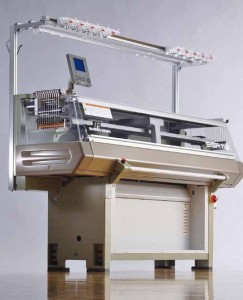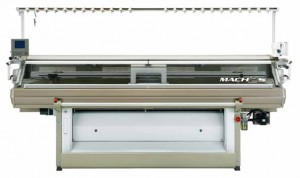Brighter prospects seen for Wholegarment flat knitting machines
 Shima Seiki has celebrated its 50th anniversary of establishment. Established in 1962 by Masahiro Shima, its current President, to develop the world’s first fully automated glove knitting machine, the company has retained its corporate spirit that seeks to offer highly advanced products at affordable prices.
Shima Seiki has celebrated its 50th anniversary of establishment. Established in 1962 by Masahiro Shima, its current President, to develop the world’s first fully automated glove knitting machine, the company has retained its corporate spirit that seeks to offer highly advanced products at affordable prices.
In fact it has led the industry in providing numerous world-first and unique products and technologies, including computerized flat knitting machines and design systems.
The impact on the global knitwear industry of WHOLEGARMENT flat knitting machines, which the company developed in the 1990s, was comparable to the advances made during the Industrial Revolution. Shima Seiki looks forward to helping shape the clothing culture through technological innovations for the development of the knitwear and apparel industries.
TEXTILE MAGAZINE: How was the market environment and operating performance during the year under review?
Masahiro Shima: We faced a number of setbacks, which had serious problematic implications for both sales and income. Although the year delivered extremely problematic operating performance, it also produced some seeds of future success. One such example was increased sales of the SSR, a strategic model that we luanched at the end of the preceding fiscal year. Although orders were lacklustre in the second half, a sharp increase in SSR sales yielded a year-on-year increase in unit sales of flat knitting machines during the year. Targeting China and other emerging markets, the model accurately met customers’ needs and, we believe, led to steady increases in our market share and brand-building.
In WHOLEGARMENT flat knitting machines and the SDS-ONE APEX3 design system (APEX3), which remained our mainstay pillar of future growth, unit sales increased. We had solid success in introducing the APEX3 to the industries outside of flat knitting, including textiles, circular knitting, lace and embroidery. From the upcoming fiscal year, we will continue to proactively promote this sort of sales strategy as we make a full-fledged effort to achieve a turnaround in operating performance.
TM: How about the current global trends in the knitwear industry?
 MS: The industry is undergoing a structural shift. Global production of knitwear products remains centered on China. Looking at our own sales, despite the decrease from the second quarter, the markets in China and Hong Kong account for more than one-third of our sales.
MS: The industry is undergoing a structural shift. Global production of knitwear products remains centered on China. Looking at our own sales, despite the decrease from the second quarter, the markets in China and Hong Kong account for more than one-third of our sales.
However, China’s position as the “workshop of the world” is gradually yielding, as economic growth and a low birthrate are giving rise to higher wages and a dearth of young workers. During the past few years, major European and US apparel companies have been pursuing a “China plus one” strategy, the “one” being a country nearby China.
This tendency toward a shift in production in other countries is accelerating, prompting a structural move away from the conventional concentration on China.
At the same time, however, China’s economic development is causing domestic demand for apparel to increase. Particularly in the vicinity of Shanghai, knitwear manufacturers targeting the domestic market and adopting an SPA model (which integrates into processes from planning through sales at a single company) have begun making aggressive capital investments.
Shima Seiki believes that manufacturers focused on domestic demand have a great deal of future potential. The knitwear industry in Turkey, a center of production serving Europe and Russia, is being reinvigorated by a return of production from China. We anticipate additional increases in demand for upgrades to computerized flat knitting machines from this market, which aims to differentiate its products from Chinese knitwear through highly efficient production and high-value-added output.
In other emerging markets, attention is focused on the rapidly growing markets of Cambodia, Bangladesh and Indonesia, which are benefiting from the production shift from China. We also see Eastern Europe as a promising market for computerized flat knitting machines. This region is emerging as a center for the manufacture of volume-zone products for European apparel customers. Furthermore, expectations are high for Brazil, a new market where knitwear production is growing to meet increases in internal demand stemming from the country’s economic growth.
Looking at markets in advanced countries, apparel manufacturers in Europe, particularly in Italy, are newly adopting a business style focusing on production in the consumer market. Accordingly, we believe this region has potential demand for WHOLEGARMENT flat knitting machines, which facilitate highly varied, small-lot production and quick responsiveness.
TM: What are your future growth strategies?
MS: We are targeting new growth centered on WHOLEGARMENT flat knitting machines and APEX3. Our future growth strategies will center on boosting sales of WHOLEGARMENT flat knitting machines.
 The benefit of WHOLEGARMENT flat knitting machines is that they ease bottlenecks in the knitwear production process caused by linking, leading to the shift from a labor-intensive industry. At present, such countries as China face rising personnel costs and shortages of workers.
The benefit of WHOLEGARMENT flat knitting machines is that they ease bottlenecks in the knitwear production process caused by linking, leading to the shift from a labor-intensive industry. At present, such countries as China face rising personnel costs and shortages of workers.
As WHOLEGARMENT flat knitting machines can help to alleviate these problems, we believe that potential demand exists not only in advanced countries, but also will grow in China and other emerging markets.
The use of WHOLEGARMENT flat knitting machines allows production of seamless knitwear products; they also allow for the creation of new types of knitwear products that have loops of differing sizes even within the same garment. In addition to product quality and attractiveness, they facilitate highly varied, small-lot production, which has in the past been cost-prohibitive. For these reasons, we believe that over the long term demand will increase in various parts of the world. In line with this conviction, during the year we set up a new factory dedicated to the highly efficient production of WHOLEGARMENT flat knitting machines.
Our second point of focus, following WHOLEGARMENT flat knitting machines, will be the APEX3 design system. This system addresses one of the bottlenecks in apparel production: the creation of physical samples. By creating high-quality virtual samples, the APEX3 greatly reduces the time and cost required for the planning process and allows for the planning of highly creative products. By enhancing the links between the APEX3 and WHOLEGARMENT flat knitting machines, we are changing the essence of the apparel business and contributing to the realization of a manufacturing process that is closely attuned to market needs.
We will also pursue applications for the APEX3 outside the knitwear industry. By mounting an aggressive effort to promote sales that allow customers to incorporate the system in plans across a broad cross-section of the apparel industry – including circular knitting, textiles, textile printing, towels and embroidery simulation – we expect these systems to evolve into a pillar of business on a par with flat knitting machines.